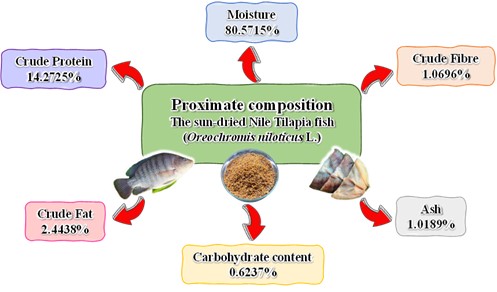Analysis of the Nile Tilapia fish's (Oreochromis niloticus L.) proximate composition in Sakon Nakhon province, Thailand
The proximate composition of Nile Tilapia fish (Oreochromis niloticus L.)
DOI:
https://doi.org/10.55674/cs.v15i2.251073Keywords:
Proximate composition analysis; the sundried Nile Tilapia fish; Farmer Pond in Sakon Nakhon Province; Oreochromis niloticus L.Abstract
Fish is a significant source of animal protein and contains additional vital nutrients for people. Fish popularly eaten in Thailand is the Nile Tilapia fish (Oreochromis niloticus L.), which is inexpensive. Therefore, this study aimed to ascertain and compare the proximate compositions of the sun−dried Nile Tilapia fish from the Suanpa Baandin farm in Chiang Khruea sub−district, Mueang Sakon Nakhon district, Sakon Nakhon province, Thailand. The parameters of proximate compositions consisting of moisture contents, crude proteins, crude fats, crude ashes, crude fibers, carbohydrate contents, and total carbohydrate contents were evaluated following the standard method from the official methods of the Association of Official Analytical Chemists International (AOAC; 2004). In this investigation, the dry matters of Nile tilapia fish were 19.43 ± 0.03%. According to the findings, the sample of sun-dried Nile Tilapia fish comprised 14.2725 ± 0.0601% of crude proteins, 2.4438 ± 0.0134% of crude fat, and 1.6933 ± 0.0460% of total carbohydrate contents, respectively. These results of the sun−dried Nile Tilapia fish showed that proximate nutritional compositions were consistent with the findings of other research reports. Therefore, the overall results indicated that the sun−dried Nile Tilapia fish samples were suitable for human protein requirements and should be recommended for consumption as it was a good source of nutrients.
References
O.A. Olopade, I.O Iyabode Olusola Taiwo, A.A. Lamidi, O.A. Awonaike, Proximate composition of Nile Tilapia (Oreochromis niloticus) (Linnaeus, 1758) and Tilapia Hybrid (Red Tilapia) from Oyan Lake, Nigeria. Bull. Univ. Agric. Sci. Vet. Med. Cluj-Napoca, Food Sci. Technol. 73(1) (2016) 19 – 23.
F. Jim, P. Garamumhango, C. Musara, Comparative analysis of the nutritional value of Oreochromis niloticus (Linnaeus), Nile Tilapia, meat from three different ecosystems, J. Food Qual. 2017(6714347) (2017) 1 – 8.
D.T. Desta, G.A. Zello, F. Alemayehu, T.K. Estfanos, K. Zatti, M. Drew, Proximate analysis of Nile Tilapia, (Oreochromis niloticus), fish fillet harvested from farmers pond and lake Hawassa, Southern Ethiopia, Int. J. Res. Dev. Technol. 11(1) (2019) 94 – 99.
D.K. Singh, A Ranjan, Comparative study on macro and micro-nutrient profiling of selected freshwater, brackish water and marine water food fishes available in Kerala, India. Food Nutr. Sci. 1(4) (2016)1 – 7.
I. Marques, G. Botelho, R. Guiné, Comparative study on the nutritional composition of fish available in Portugal, Nutr. Food Sci. 49(5) (2019) 925 – 941.
A. Jaya-Ram, F. Fuad, M.S. Zakeyuddin, A.S.R.M. Sah, Muscle fatty acid content in selected freshwater fish from Bukit Merah Reservoir, Perak, Malaysia. Trop. Life. Sci. Res. 29(2) (2018) 103 − 117.
M.R. Ullah, M.A. Rahman, M.N. Haque, M.R. Sharker, M.M. Islam, M.A. Alam, Nutritional profiling of some selected commercially important freshwater and marine water fishes of Bangladesh, Heliyon. 8(10) (2022) e10825.
M.D. woyemi, A.A. Eyo, Studies on the use of salt, vegetable oil and insecticide for control of dermestes maculates infecting dried fish in storage, FAO Fisheries Report. 574 (1998) 103 – 104.
N. Fitri, S.X.Y. Chan, N.H. Che Lah, Jam, F.A.N.M. Misnan, N. Kamal, M.N. Sarian, M.A. Mohd Lazaldin, C.F. Low, H.S. Hamezah, E.R. Rohani, A. Mediani, F. Abas, A comprehensive review on the processing of dried fish and the associated chemical and nutritional changes, Foods. 11(19) (2022) 2938.
N. Tenyang, R. Ponka, B. Tiencheu, F.T. Djikeng, H. M. Womeni, Effect of traditional drying methods on proximate composition, fatty acid profile, and oil oxidation of fish species consumed in the Far-North of Cameroon, Glob. Chall. 4(8) (2020) 2000007.
A.O. Oko, B.E. Ubi, A.A. Efisue, N. Dambaba, Comparative analysis of the chemical nutrient composition of selected local and newly introduced rice varieties grown in Ebonyi State of Nigeria, Int. J. Agric. For. 2(2) (2012) 16 – 23.
D.K. Verma, P.P. Srivastav, Proximate composition, mineral content, and fatty acids analyses of aromatic and non–aromatic Indian rice, Rice Sci. 24(1) (2017) 21 – 31.
Z.K. Akalu, S.H. Geleta, Comparative analysis on the proximate composition of tubers of Colocasia Esculenta, L. Schott and Dioscorea alata cultivated in Ethiopia, Am. J. Biosci. Bioieng. 7(6) (2019) 93 – 101.
P.C. Eze, Determination of the proximate composition and amylose content of new rice for Africa (NERICA) flour, Turk. J. Agr. Eng. Res. 1 (2020) 131 – 140.
A.D. Premarathna, A.M.C.P. Kumara, A.P. Jayasooriya, D.A. Satharasinghe, E. Pathirana, Proximate analyses of Nile tilapia (Oreochromis niloticus) and Black Tiger Prawn (Penaeus monodon) from Sri Lanka, Oceanogr. Fish Open Access J. 7(5) (2018) 1 – 5.
F.A. Anani, E. Agbeko, Health condition and proximate composition of Nile tilapia (Oreochromis niloticus L.) fed with tilapia grower diets of commercial, farm-made and their 1:1 mixture, J. Fish. Aquat. Res. 3(1) (2018) 9 – 15.
M.M. Gaber, Growth of Nile tilapia fingerling (Oreochromis niloticus) fed diets containing different levels of clove oil. Egypt, J. Aquat. Biol. Fish. 4 (2000) 1 – 18.
United State Department of Agriculture (USDA), Agricultural research service, national nutrition database for standard reference. Release, 23 Nutrition Laboratories, 2010.
T. Tsegay, P. Natarajan, T. Zelealem, Analysis of diet and biochemical composition of Nile Tilapia (O. niloticus) from Tekeze Reservoir and Lake Hashenge, Ethiopia. J. Fisheries Livest. Prod. 4(2) (2016) 1 – 7.
L.A. Alemu, A.Y. Melese, D.H. Gulelat, Effect of endogenous factors on proximate composition of Nile tilapia (Oreochromis Niloticus L.) fillet from Lake Zeway, Am. J. Res. Commun. 1(11) (2013) 405 – 410.

Downloads
Published
How to Cite
Issue
Section
Categories
License
Copyright (c) 2023 Creative Science

This work is licensed under a Creative Commons Attribution-NonCommercial-NoDerivatives 4.0 International License.








